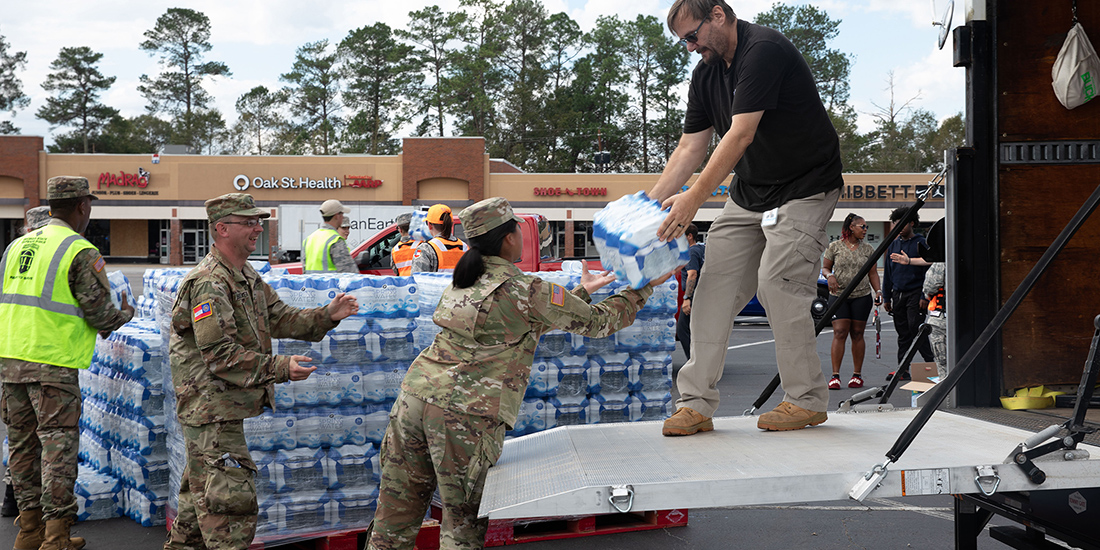As disasters grow in frequency, state emergency management leaders face a mounting challenge: how to expand response capacity without dramatically expanding cost. National Guard units are increasingly stretched thin. Federal resources—including those of the Federal Emergency Management Agency (FEMA)—face budgetary headwinds and growing demands. And mutual aid systems, while vital, are not infinite.
The Army National Guard’s 2024 strategic outlook, “The Army National Guard Beyond 2030,” reinforces the urgency. It warns that overseas deployments, training burdens, and rising domestic missions are eroding the Guard’s “part-time, community-focused” identity, creating increasing opportunity costs and mission fatigue. Meanwhile, from 1980 to 2023, the U.S. faced more than 360 environmental disasters exceeding $1 billion—a trend accelerating both in frequency and cost. As the National Guard experiences a rise in mission demands, their need for personnel continues to expand, limiting its ability to support disaster response.
States already have a trained, ready, and cost-effective surge force at their disposal. Title 32 State Defense Forces (SDFs)—federally sanctioned, state-authorized, governor-controlled military organizations—are already stepping up in real-world emergencies. Yet they remain largely absent from formal emergency operations plans, even as recent operations show their capacity to enhance state and local resilience across multiple mission sets.
A Surge Force for the Challenges Ahead
Unlike the National Guard, SDFs cannot be federalized or deployed overseas. They exist to serve state missions, under state control, and, as volunteers—often unpaid—they operate at a fraction of the cost. In fact, most SDF members pay for their own uniforms and personal equipment. Most are trained in FEMA’s Incident Command System (ICS) and the National Incident Management System (NIMS), making them interoperable with both civil and military responders. Many also receive military-style mission command training, enabling them to lead in complex, multi-agency operations.
In the 24 months prior to this writing, they have proven their value repeatedly:
- The Florida State Guard deployed during three back-to-back hurricanes in 2023 and 2024—Hurricanes Idalia, Nicole, and Pablo. Their missions included staffing and managing emergency shelters, operating logistics hubs in storm-impacted counties, water rescues, assisting with evacuations, and delivering critical supplies. Florida SDF personnel were embedded in emergency operations centers and worked alongside local law enforcement and National Guard elements. They also crossed state lines under the Emergency Management Assistance Compact to support storm recovery and shelter operations in Georgia and North Carolina.
- The Georgia SDF activated for Hurricane Helene in September and October 2024. Its personnel conducted debris clearance, distributed food and water, and supported shelter operations in rural South Georgia communities. They operated in tandem with the Georgia National Guard, helping reopen critical transportation routes and restoring access to hospitals and emergency services.
- The South Carolina State Guard responded twice in rapid succession in late 2024—first during Hurricane Helene, providing traffic control and communications augmentation, and later in response to historic flooding in Orangeburg County. In the flood mission, SDF personnel conducted sandbagging, water rescue support, and damage assessments, relieving overburdened local fire departments and public safety agencies.
- The Alaska SDF deployed in May 2023 alongside the Alaska National Guard to assist in flood recovery operations in Circle, Alaska, a remote community cut off by washed-out roads. Defense Force members helped establish field communications, coordinated supply airlifts, and provided humanitarian aid, underscoring the importance of having locally governed, rapidly deployable forces in geographically isolated and underserved regions.
- The Texas State Guard has played a critical role in both disaster response and border security operations. In 2023 and 2024, personnel supported Operation Lone Star by assisting state and local law enforcement in humanitarian relief and infrastructure protection along the U.S.–Mexico border. During Winter Storm Uri response operations, Texas State Guard units conducted wellness checks, distributed food and water, supported warming shelters, and helped restore communications across rural counties. Their integrated support across state agencies illustrates how SDFs can augment both emergency management and public safety missions.
These are not anomalies. They are a pattern of success.
A Role That Fits the Emergency Management Mission
SDFs have also demonstrated their effectiveness in specialized missions beyond traditional disaster response.
Public Health Support
During the height of the COVID-19 pandemic, SDFs across multiple states managed testing and vaccination sites, distributed personal protective equipment, supported medical logistics, and staffed emergency operations and public information centers. Their ability to mobilize quickly and sustain operations proved vital during the prolonged national emergency.
Cyber Defense
The Maryland and Virginia Defense Forces, among a handful of states, have integrated civilian cyber professionals into critical infrastructure protection efforts. Maryland’s SDF cyber teams supported vulnerability assessments and cyber defense exercises with the Maryland National Guard. Virginia’s Cyber Battalion executed penetration testing and audits during state-level cybersecurity drills. These examples illustrate how SDFs can enhance cyber readiness in collaboration with civilian agencies and Guard units.
SDFs are ideally suited to support the very missions that stretch traditional forces:
- Shelter management and logistics operations
- Medical surge support and casualty tracking
- Cyber incident response and communications restoration
- Command, control, and continuity of government operations
They are scalable, flexible, and already authorized by federal law. And they are trained to operate within the systems that emergency managers already use.
Structural Barriers, Not Capability Limits
So why are SDFs not integrated more widely? The answer is not operational—it is bureaucratic. SDFs exist outside FEMA’s grant structure. They are not funded under the Stafford Act and do not neatly align with traditional federal chains of command. But these are policy problems, not capability problems. And they are solvable.
A Call to Emergency and National Security Leaders
State and federal decision-makers must act now. Consider these steps:
- Codify SDF roles in the state emergency operations plan, aligned to NIMS and ICS standards.
- Integrate SDFs into exercises, credentialing, and training pipelines alongside National Guard and mutual aid partners.
- Advocate for grant eligibility and flexible use of federal resources for Title 32–authorized missions.
- Leverage the Emergency Management Assistance Compact more broadly, building on Florida’s 2024 precedent to enable cross-border SDF support.
- Establish interoperability standards across all three components—active-duty, Guard, and SDFs—to ensure seamless coordination in joint operations.
Capacity Without Complexity
SDFs are not a replacement for the National Guard. They are a complementary force, purpose-built for local missions. In an era of shrinking federal resources, rising mission demand, and long-duration emergencies, SDFs offer something rare: capability without complexity. They are trained, trusted, and ready. It is time to give them the mission space—and recognition—they have earned.

Robert Hastings
Robert Hastings is a retired brigadier general in the Texas State Guard, a retired Regular Army officer, and a former Assistant to the Secretary of Defense for Public Affairs. He is the author ofPeople First: Mission Alwaysand principal of Robert Hastings & Associates, a strategic communications consultancy focused on aerospace and defense.
- Robert Hastingshttps://www.domesticpreparedness.com/author/robert-hastings






